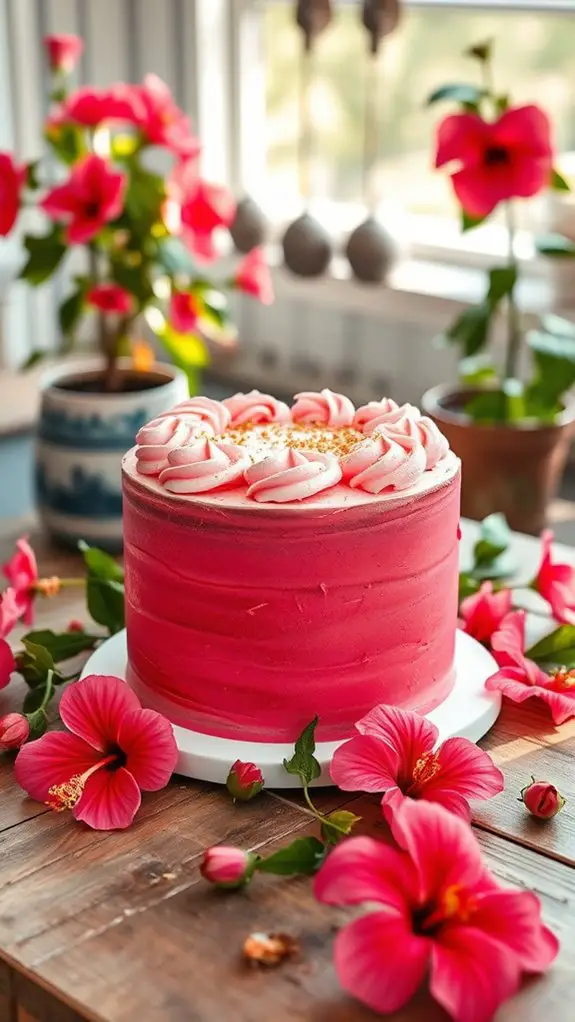You've likely encountered hibiscus in teas and juices, but have you considered its potential as a cake ingredient? This vibrant, tart flower lends itself beautifully to baking, creating a unique dessert that fascinates the senses. Curious to learn more about this tropical twist on a classic treat? Uncover the history, recipe, and nutritional benefits that make hibiscus cake a fascinating addition to any sweet repertoire.
History

Although the exact origins of the hibiscus cake are unclear, it's believed to have emerged from the rich culinary traditions of tropical regions.
The hibiscus flower, with its vibrant hues and distinctive tart flavor, holds deep cultural significance in many parts of the world. Historically, it has been revered for its medicinal properties and used in ceremonial rituals.
The incorporation of this blossom into a cake reflects the ingenuity of local cooks, who skillfully harnessed its unique attributes to create a delectable dessert.
Over time, the hibiscus cake has evolved, with variations emerging across different cultures, each offering a unique interpretation of this iconic tropical treat.
Recipe

Hibiscus has a vibrant, tart flavor that pairs beautifully with the sweetness of a delicate cake. This recipe captures the essence of the hibiscus flower, creating a visually stunning and delightfully flavored dessert.
The use of fresh or dried hibiscus flowers, combined with a moist and tender crumb, results in a truly unique and memorable cake. Serve this hibiscus cake as a showstopping centerpiece for any special occasion.
- 2 cups all-purpose flour
- 1 teaspoon baking powder
- 1/2 teaspoon baking soda
- 1/4 teaspoon salt
- 3/4 cup unsalted butter, softened
- 1 1/2 cups granulated sugar
- 3 large eggs
- 1 teaspoon vanilla extract
- 1 cup buttermilk
- 1/2 cup dried hibiscus flowers, finely chopped
Preheat the oven to 350°F. Grease and flour a 9-inch round cake pan.
In a medium bowl, whisk together the flour, baking powder, baking soda, and salt.
In a large bowl, cream the butter and sugar until light and fluffy. Beat in the eggs one at a time, then stir in the vanilla.
Alternately add the flour mixture and buttermilk to the batter, mixing just until incorporated. Fold in the chopped hibiscus flowers.
Pour the batter into the prepared pan and bake for 35-40 minutes, or until a toothpick inserted in the center comes out clean. Allow the cake to cool completely before serving.
For best results, use fresh or high-quality dried hibiscus flowers. The cake can be served plain or topped with a light dusting of powdered sugar or a hibiscus-infused glaze.
Nutritional Guide
This hibiscus cake offers a nutritional profile that's both unique and well-balanced.
It's rich in antioxidants from the vibrant hibiscus flowers, providing benefits like reduced inflammation and improved heart health. An ingredient analysis reveals a good source of complex carbohydrates, moderate amounts of protein, and minimal fat.
The cake also contains vitamins and minerals like vitamin C, iron, and calcium. Overall, this treat is a delicious way to incorporate more nutrient-dense ingredients into your diet and support your wellbeing.
Whether you're looking for a healthier dessert or simply want to enjoy the flavors of hibiscus, this cake is a nutritious and satisfying option.
Final Thought
Given the nutritious profile of the hibiscus cake, you may find it a delightful and wholesome addition to your dessert repertoire.
As culinary trends continue to embrace natural, vibrant ingredients, the hibiscus cake's distinct flavor and eye-catching appearance make it a versatile option.
Pair it with complementary flavors like citrus, coconut, or even spices to create enchanting flavor pairings. Its bright hue and subtle tartness can lend a rejuvenating contrast to richer desserts.
With its blend of healthful elements and appealing aesthetic, the hibiscus cake presents an inviting opportunity to explore innovative and nutritious options within your culinary repertoire.